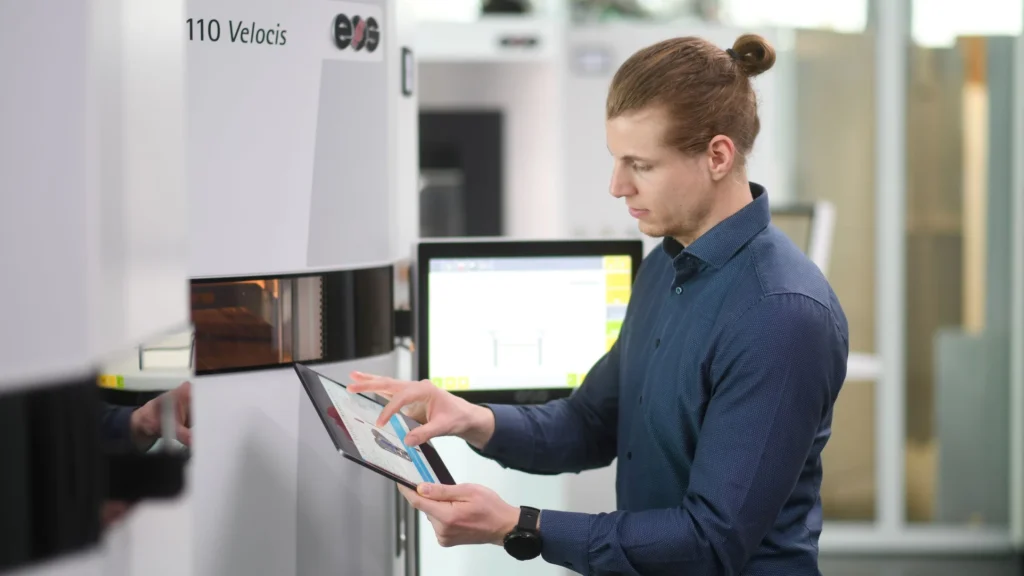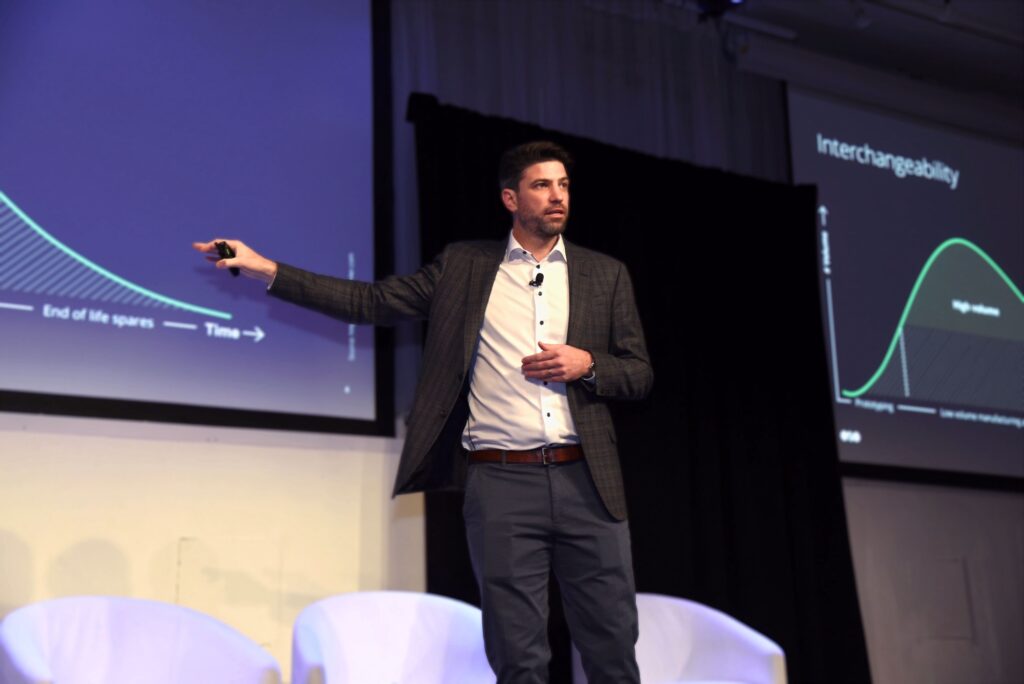It’s easy to forget sometimes that social media isn’t reality. So, at the end of 2023, when a burst of doom and gloom started to spread across the Western world’s additive manufacturing (AM) network on LinkedIn, the pessimism started to quickly perpetuate itself — a process that, not coincidentally, happened in-line with a notably dismal quarter for AM companies publicly traded on US markets.
Dr. Gregory Hayes, who was recently named Senior Vice President of Global at EOS’s Additive Minds engineering consultancy, is not buying into the pessimism. Indeed, when I saw Hayes’ presentation at Additive Manufacturing Strategies (AMS) in New York City at the beginning of February, I was struck not only by his refreshingly upbeat tone, but equally, by the realistic and detailed premise it was built on.
Although he didn’t allude to the pessimism in his discussion, Hayes did mention how many of the people in the AM industry — including himself — seem to all be connected to more or less the same people. This was especially interesting given how few of those people Hayes said he actually knew, a fact that presumably generalizes across-the-board for professionals in the industry. (After his talk, I went up to Hayes and introduced myself, asked him if he’d be interested in an interview, and pointed out that we were connected on LinkedIn even though we’d never interacted in any way.)
Hayes’s point was that, particularly because it’s such a relatively small world, the AM industry in the West acts as an echo chamber. This limits the industry’s imagination, and often allows the pessimistic views to spread more easily than optimistic ones. A couple of weeks after AMS, at the end of our interview, Hayes’ reiterated his same conviction in the virtues of maintaining a sunny outlook: “Even though I’m saying we need to do some things differently in the industry, I don’t want that to be misconstrued as coming from a place of negativity. We need to inject some positivity back into AM.”
To step back a bit, when Hayes refers to what he thinks the AM industry should do “differently”, he’s talking about a shift of focus, from an insular view of what makes the underlying technologies involved unique, to an externally-focused mindset driven by consideration of how AM can fill in for other manufacturing technologies where and when it’s needed. In other words, Hayes is encouraging industry professionals to proactively seek out all of the opportunities for AM to help the manufacturing sector at-large alleviate its worst strategic liabilities:
“In many ways, we siloed ourselves into market segments which had a ceiling on them,” Hayes explained, “and I still see too much of this in the industry. For instance, there are still people arguing that what we need to do is find precisely the areas where the uniqueness of additive exploits an application. And I take issue with this, to the extent that actually, I think we need to do the complete opposite of that.
We need to find areas where multiple technologies can be used to manufacture a given part, where additive can excel as a supplemental technology — a technology to fix supply chain pain points. This is where I think all the low-hanging fruit is. Now, every individual supply chain disruption may be temporary, but disruptions to supply chains in general seem to be permanent at this point. As one disruption recedes, another one comes into play. The role that additive can assume in that landscape is to serve as a flexible production capacity source, which can seamlessly step in as each disruption crops up.”
Along those lines, it’s not surprising which sectors Hayes said the industry should be most focused on targeting. They’re strategic segments, the ones most susceptible to supply woes, and which have the greatest potential to spread their own risk throughout the rest of the economy:
“In the US, at least, the industries that we view as the best opportunities for leveraging AM as a supply chain resilience solution are automotive, medical, and semiconductors,” Hayes said. “By semiconductors, I’m not referring directly to chips manufacturing, but more broadly, the entire ecosystem surrounding it, specifically semiconductor capital equipment. And, of course, the most widely-discussed area is the defense industrial base. All of these market segments can benefit from the flexibility, and the redundancy, that additive can bring to the table.
“To be sure, there are many hurdles to this becoming a reality, beyond all the issues explicitly related to AM. The most crucial and critical challenge, for both reshoring and nearshoring, is workforce development. Then, while the labor force is being built up, you need to actually stand up the supply base that the AM industry is dependent on for growth. These are difficult challenges, but I also think that they’re solvable ones.”
The need to prioritize increased manufacturing workforce development in nations such as the US comes up with virtually everyone I interview at this point. Hayes is one individual who is truly in a position to help do something about it, given how central that objective is to the work of Additive Minds. When I asked him which area of the AM workforce he’d like to see get the most immediate attention, he didn’t hesitate with his response:
“Certified operators,” said Hayes. “Oftentimes, when additive fails to take hold in an organization attempting to incorporate it into its workflows, it’s either because that organization has untrained operators, or simply doesn’t have enough trained operators to adopt AM successfully. And certainly, there’s some truth to the flip side of that point, which is that we need to design machines that are easier to use. So those two aspects need to come together — if, as OEMs, we make systems that are easier to familiarize the workforce with, it’ll also broaden the pool of potential workers that we can bring into the industry. In the meantime, though, we still need to focus on certifying as many operators as possible, as quickly as possible. That’s something that EOS excels at, and not just on its own. We like to partner with organizations like ASTM to get that done, and it always helps to have a neutral body with the necessary expertise to make sure we’re bringing more trained operators into the fold, certified in the standard processes.”
Another organization that EOS and Additive Minds have frequently partnered with for organizational development is the Department of Defense (DoD). Since, as Hayes noted, the US defense industrial base is one of the biggest success stories in terms of AM adoption in the last few years, I asked him if he thinks DoD provides a useful model that can be applied to other industries:
“I think that the work the Department of Defense is doing, especially the Navy, is an awesome model for how to go from zero to up-and-running with additive,” Hayes affirmed. “And they’re putting it out there for everyone to see. There are many different concepts that they’ve adopted that should be standard for any enterprise trying to do the same thing. There’s the concept of taking a technical data package and wrapping it an additive application, then distributing it in a secure and fixed way to an install base. There’s the concept of being able to multi-source from different OEMs that the Navy is concerned with, which I think is a highly necessary one for many different industries. Then, because of the government subsidy angle, they can activate all the material science know-how and other advantages from research institutions that lies at their fingertips. It’s a great model that they’ve been able to implement, and I’d be lying if I said we weren’t influenced by that type of implementation model in our approach to other industries.”
Hayes himself is an apt model for the next generation of AM leadership. But, as he is quick to point out, this is precisely because he has had access to all the gains gifted to him by the industry’s previous generations of experts. Hayes simply wants to take that foundation and leave it in the best possible position for the generation that follows him:
“We shouldn’t discount the past,” Hayes told me. “There’s a reason why we are where we are. All of the minds that have been opened by what additive has done up to this point, at research organizations and innovation departments, were one hundred percent necessary to get us to the point we’re at now. But now the industry is growing up, and we need to stand on our own two feet, and be mature in our approach. That means we need to step into real manufacturing. And real manufacturing solves the demand for components that exist today, not the futuristic potential demand that may be there in the years ahead.”
Unless otherwise noted, images courtesy of EOS.
Subscribe to Our Email Newsletter
Stay up-to-date on all the latest news from the 3D printing industry and receive information and offers from third party vendors.
You May Also Like
Further Understanding of 3D Printing Design at ADDITIV Design World
ADDITIV is back once again! This time, the virtual platform for additive manufacturing will be holding the first-ever edition of ADDITIV Design World on May 23rd from 9:00 AM –...
3D Printer Maker EVO-tech Reborn as NEVO3D — Once More With Feeling
EVO-tech was a 3D printing service and original equipment manufacturer established in 2013 and based in Schörfling am Attersee, Austria. The company produced high-quality material extrusion systems featuring linear bearings,...
3D Systems Brings 3D Printed PEEK Cranial Implant to the U.S. with FDA Clearance
For more than 10 years, 3D Systems (NYSE:DDD) has worked hand-in-hand with surgeons to plan over 150,000 patient-specific cases, and develop more than two million instruments and implants from its...
CDFAM Returns to Berlin for Second Annual Symposium
The second CDFAM Computational Design Symposium is scheduled for May 7-8, 2024, in Berlin, and will convene leading experts in computational design across all scales. Building upon the first event...


































